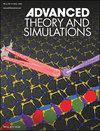探索非共轭化合物光学活性特征的结构基础的机器学习研究
IF 2.9
4区 工程技术
Q1 MULTIDISCIPLINARY SCIENCES
引用次数: 0
摘要
各种各样的研究旨在阐明为什么某些分子比其他分子表现出增强的非线性光学(NLO)响应。这种知识有利于设计新的NLO开关,使其ON/OFF状态能够显示其NLO行为。基于非共轭晶体体系的重要性,本研究旨在通过生长2,4 -二氨基三硝唑晶体,通过机器学习(ML)分析来确定极化率/第一超极化率的驱动力。研究表明,如何将化合物的简化分子线输入系统(SMILES)输入到大极化率/超极化率数据中才能显示其NLO响应。结果表明,它们的极化率与HOMO-LUMO能隙之间有很好的相关性。他们的SHapley加性解释(SHAP)分析表明,基态和第一激发态之间的跃迁偶极矩()是这种分子系统的主要贡献者之一。研究还表明,除了各种非共轭相关氧化还原状态外,ML模型还可以充分表征这些NLO反应。本文章由计算机程序翻译,如有差异,请以英文原文为准。
A Machine Learning Study to Explore the Structural Basis of Non‐Conjugated Compounds for Their Optical Activity Features
Various investigations have been aimed to elucidate that why certain molecules exhibit an enhanced nonlinear optical (NLO ) response than others. Such kind of knowledge is advantageous to design of new NLO switches where their ON /OFF states can display their NLO behavior. Based on the significance of nonconjugated crystal systems, the current study aims at identifying the driving forces of the polarizability/first hyperpolarizability through machine learning (ML ) analysis by growing crystal of 2,4‐diaminotrotriazole. The study shows that how input of a Simplified Molecular Line Entry System (SMILES ) of compound into a large polarizability/hyperpolarizability data can display its NLO response. The results show a good correlation between their polarizability and the HOMO–LUMO energy gaps. Their SHapley Additive exPlanations (SHAP ) analysis reveals that the transition dipole moment () between the ground and first excited state is one of the primary contributors for such molecular systems. It is also illustrated that, besides various non‐conjugated related redox states, the ML model can adequately characterize these NLO responses.
求助全文
通过发布文献求助,成功后即可免费获取论文全文。
去求助
来源期刊

Advanced Theory and Simulations
Multidisciplinary-Multidisciplinary
CiteScore
5.50
自引率
3.00%
发文量
221
期刊介绍:
Advanced Theory and Simulations is an interdisciplinary, international, English-language journal that publishes high-quality scientific results focusing on the development and application of theoretical methods, modeling and simulation approaches in all natural science and medicine areas, including:
materials, chemistry, condensed matter physics
engineering, energy
life science, biology, medicine
atmospheric/environmental science, climate science
planetary science, astronomy, cosmology
method development, numerical methods, statistics
 求助内容:
求助内容: 应助结果提醒方式:
应助结果提醒方式:


